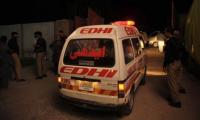NEW YORK: As temperatures soar around the world, practical experiments are emerging to protect people.
As dangerous heat becomes impossible to ignore, an array of practical innovations are emerging around the world to protect people most vulnerable to its hazards.
They offer a window into the need to adapt to the new dangers of extreme heat that have played out vividly in recent weeks, killing still-untold numbers of religious pilgrims, tourists and election workers around the world and driving up emergency room visits for heat-related ailments in the US.
The World Meteorological Organization has said that heat now kills more people than any other extreme-weather hazard and has called for many more “tailored climate products and services” to protect people’s health, including easy-to-use tools to find help.
Iphigenia Keramitsoglou is an atmospheric physicist who specializes in remote-sensing data. Dr. Keramitsoglou led a team that built a cellphone app to give users real-time information about how to stay cool.
Put your location into Extrema Global and it will show the outside temperature, air quality and color-coded levels of heat risk. It will populate a map with places to cool down: parks, pools, fountains and air-conditioned public buildings like libraries. Tell the app where you want to go — say, from an apartment to a museum — and it will offer three options: the fastest route, the coolest route and the coolest route with places to rest. An early avatar of Extrema Global was launched in 2018 in Athens. The app has since expanded to include Paris, Milan and Rotterdam. Other cities have spawned similar apps. Melbourne has an app that maps shaded routes for walkers and cyclists, and Barcelona has a mobile app that maps the city’s fountains.
Hansa Ahir, a 55-year-old grandmother of two, goes to work before sunrise to keep her city from drowning in its own trash. On average, she makes 200 rupees a day, around $2.40. Since March, she said, extreme heat has cut her income by half. By midmorning, it’s too hot to work. There are no public taps to refill her water bottle. She’s been sick. What’s kept her going is a tiny new insurance program that acts as a safety net on days of dangerous heat, offered to her by the Self-Employed Women’s Association, an organization of 2.9 million women that Ms. Ahir joined 20 years ago. The insurance policy cost her 200 rupees for a year of coverage.
The tiny insurance idea was pitched to the women’s association by an American climate finance expert, Kathy Baughman McLeod She raised $250,000 to defray the cost of premiums. This year, 50,000 members signed up — market vendors, subsistence farmers and waste recyclers like Ms. Ahir.
The program works like this: When temperatures are projected to reach danger levels, Ms. Ahir receives warning messages on her cell phone. When temperatures reach that threshold, insurance payments are triggered. In May, when the city’s maximum temperature reached 104 degrees Fahrenheit, or 40 Celsius, for three consecutive days, Ms. Ahir received a payout of 400 rupees in her bank account. With it, she bought medicine and groceries. In June, when daily highs spiked to 115 degrees Fahrenheit, she received an additional 750 rupees. With that, she paid her rent.
Like many children of farmworkers, Edgar Franks began helping his parents in the fields before he was in middle school. Now 44, Mr. Franks helps a new generation of farmworker families adapt to a new danger: extreme temperatures, mixed sometimes with wildfire smoke that hangs thick over the fields. Franks organized farmworkers to press Washington State to put in place new rules to protect farmworkers’ health. When temperatures reach 80 degrees Fahrenheit, farmworkers are entitled by law to ask for shade, water and paid breaks. Washington is one of only five states in the country to have outdoor worker protection rules in place. It’s a contrast to rollbacks of similar rules in Texas and Florida, where state laws now prohibit local ordinances that had entitled outdoor workers to mandatory water and rest breaks on excessively hot days. Washington’s heat protection rules first came in 2008, but the old threshold of 89 degrees Fahrenheit wasn’t enough to protect outdoor workers. The current emergency rules, with the lower threshold, were finalized in 2023.
The show cause notice was issued under Section 7 and Section 5 of the PEEDA Act, 2006
According to government sources, the volume of Pakistan-Afghan bilateral trade in July, August 2024 was $27.80 million
Two sugar mills, owned by Tareen, have been allotted quota of 4,028 metric tonnes and 3,161 metric tonnes
“It would be more appropriate for your client to approach the election tribunal,” the judge suggests
The committee chairman pointed out discrepancies in government communications regarding the USC’s future
Justice Tariq Mehmood Jahangiri says if court order is not implemented, interior secretary should appear at the next...







